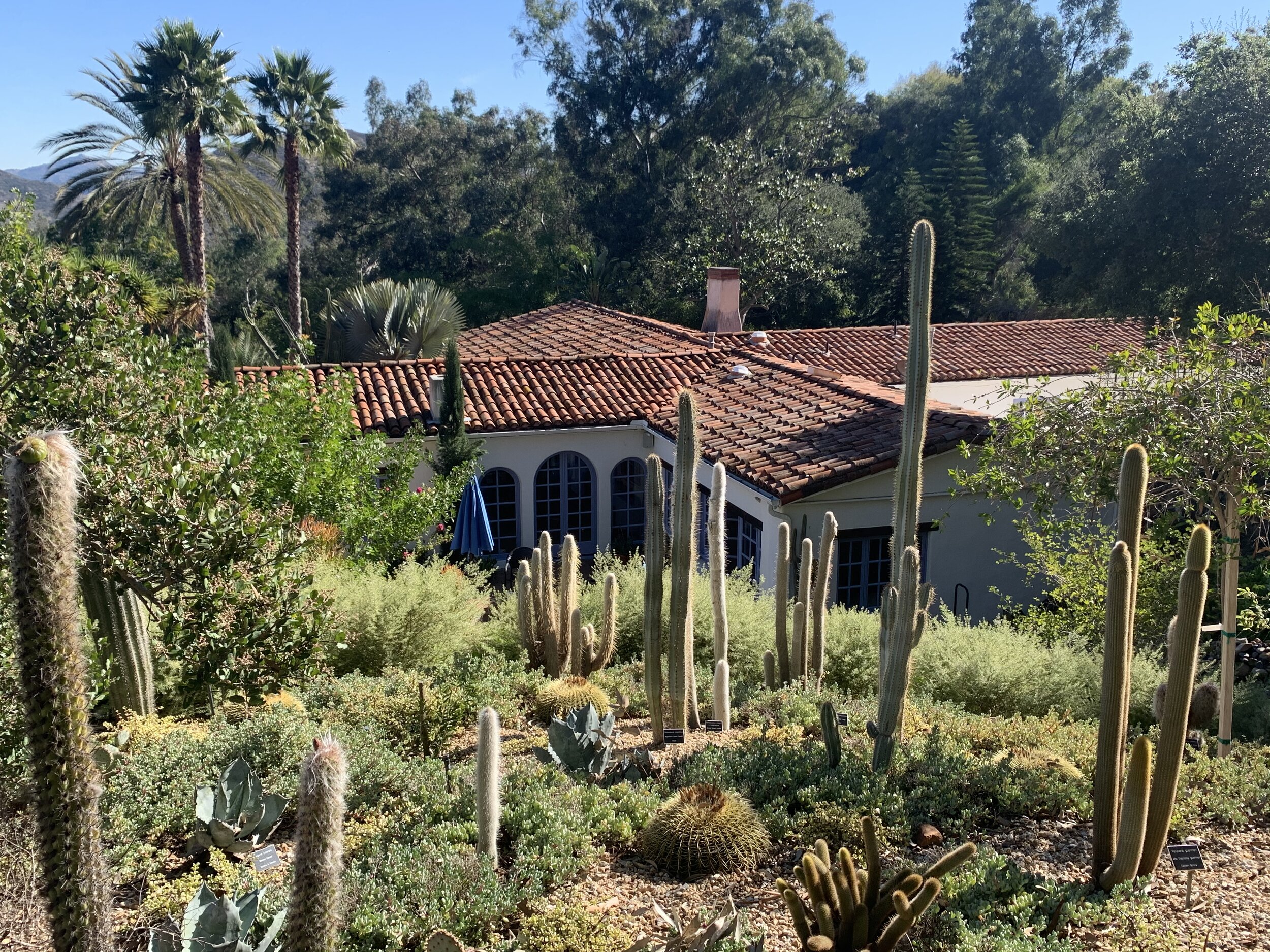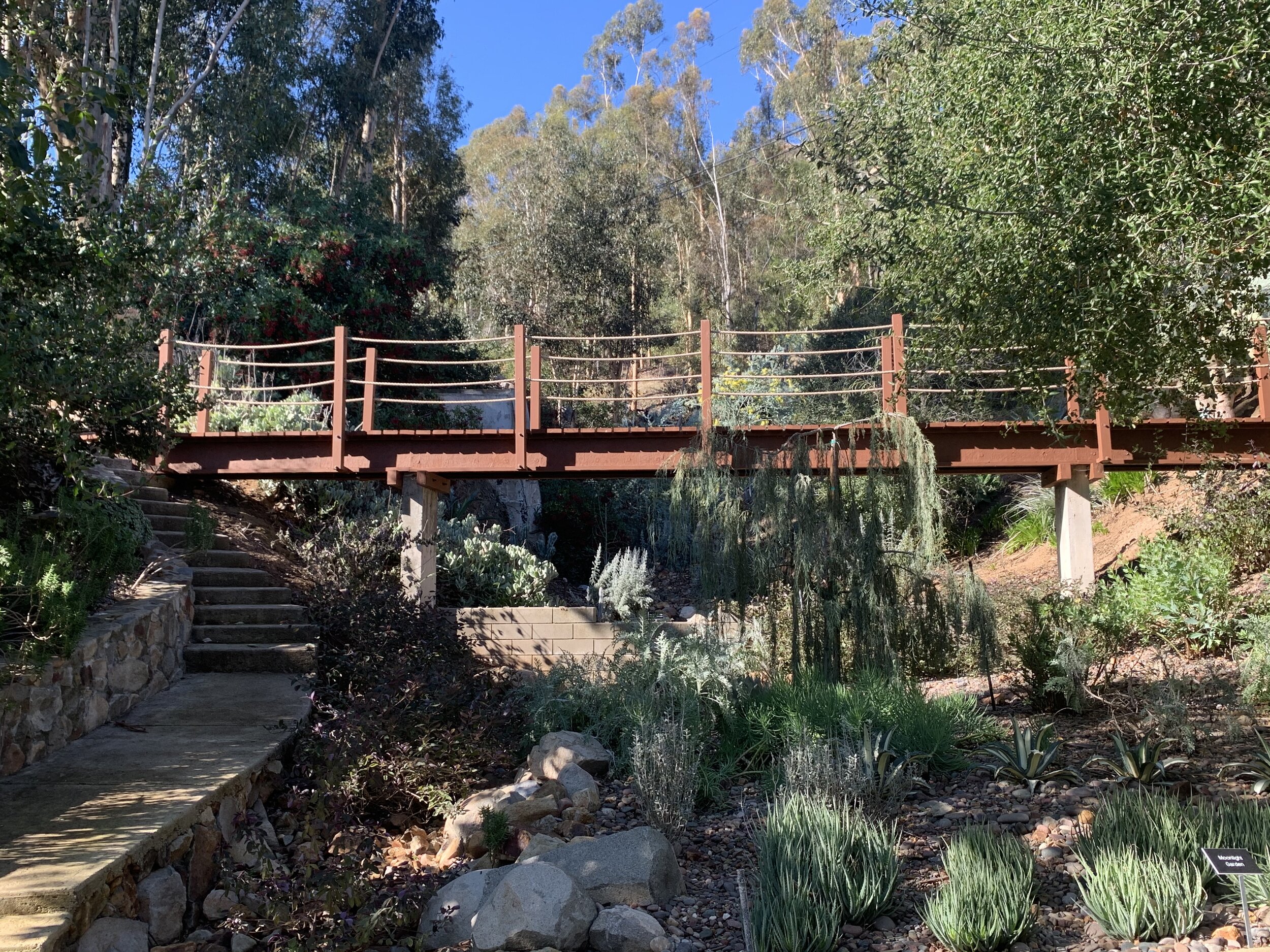Gardens
The Gardens at Hidden Lake Ranch
“The scope of the estate and its history demand attention to detail,” says Steven Anthony, the horticulturist who spearheaded the property’s most recent design and restoration efforts that reflect history as well as the modern need for drought tolerance. The end result is a fusion of period gardens, native plants, Shinto meditation areas, Art Deco and Spanish restoration gardens, with nods to Moroccan and Victorian design. Anthony drew inspiration from such renowned Southern California plantscapes as those at the Getty Center, the Huntington Botanical Gardens, and even Disneyland! Following are Anthony’s descriptions of the discrete garden spaces surrounding the house…
Home Entry Garden
This garden is a fusion of unusual xerophytes from the world’s deserts, including the bold statement of Golden Barrels that the owner planted at the entry of the home. This garden features an endangered species cactus, Lophocereus schottii monstrose, from Baja, California. There are two plants from Madagascar in this garden: Bismarkia nobilis palm and Pachypodium geayii. Another featured plant from Africa is the potted Testudinaria elephantipes.
Front Entry Dry Streambed
Adjacent to the entry gardens, this garden features a border of salvia ‘Hot Lips’ and a rocked interior with Mexican fountain grass, red penstemon grasses, Asparagus meyerii, Brahea armata v. Clara and Calocephalus brownii.
Art Deco Garden
The 1920s saw a transition from Victorian-influenced rose gardens into a “Great Gatsby” fusion period of Art Deco and Spanish Restoration plantings. Both elements are represented here.
This garden features a collection of period porcelain vases, pots, fountain, buffets and a baptismal font, all crafted in the middle 1920s by the Gladding, McBean & Company ceramics manufacturer. The design’s nod to the Spanish Restoration period includes raised circular planters adorned with Spanish tiles, planted with sago palms and King of Balcon geraniums, a French influence. The Art Deco period is also acknowledged here through the use of dwarf Italian cypress and dwarf Thuja. Remnants of the Victorian era are seen in the vining and Iceberg roses, and annual flowering plants. This is a wonderful place to enjoy a quiet morning coffee.
Evening Campfire Entertainment Area
I have primarily used period-piece plants in proximity of the home, as the original developers hailed from the Los Angeles/Hollywood area. It is my assumption that they brought this culture with them to Del Dios and infused it into agrarian life. I have used dwarf Italian cypress, gardenias and red flowering hibiscus to adorn this area. We are growing a calliandra hedge to protect the existing adobe wall in this garden. Above the adobe wall is the Water Cascade Canyon. Adjacent to the Evening Campfire Garden lies the Moonlight Garden.
Moonlight Garden
Moonlight Gardens are planted with white- and powder blue-foliaged plants, which best reflect moonlight. This garden features one of my favorite pendulous trees: Tolleson’s Weeping Juniper blue form. Adorning the surrounding area of the juniper are white-foliaged and flowering plants: Centaurea gymnocarpa; Teucrium fruticans azureum; Lavandula Goodwynn Creek; matilija poppy; Senecio vitatta; and Agave americana medio-picta. Also planted in this garden is the original variegated Ghost medio-pictate agave, Agave huachuchensis medio-picta.
Canyonlands
There are three canyons on the estate of Hidden Lake Ranch. Two of the canyons, the Desert Nature Canyon and the Water Cascade Canyon, feature constructed bridges which allow the observer to view the plantings from an overview. The California Nature canyon has been kept natural, as it is filled with native oak trees. A yoga and meditation deck sits above this area.
Desert Nature Canyon
Located behind the Moonlight Garden, this garden features white and powder blue cactus and other xerophytes including Puya alpestris, a terrestrial bromeliad from Chile. As in nature, they are planted on the canyon walls. The dry streambed is planted with Desert Museum Palo Verde, Maireana sedifolia from Australia, and Chondropetalum elephantinum, a bush from Africa.
Water Cascade Canyon
The Water Cascade Canyon originally began as a Brazilian statement, utilizing variegated abutilons. However, the squirrels defoliated the plants. The solution was to install more drought-tolerant plants not on the squirrel’s menu. The Water Cascade Garden features Acacia cognate; Pendulous agonis flexuosa var. Nana, a beautiful weeping tree from Australia; grevilleas; Singapore Orchid Trees, or Bauhinia galpinii; calliandras, v. Duranta erecta; Leucospermums and other drought-tolerant flowering shrubs and trees.
We hope you enjoy exploring and are inspired by these distinct garden spaces!






